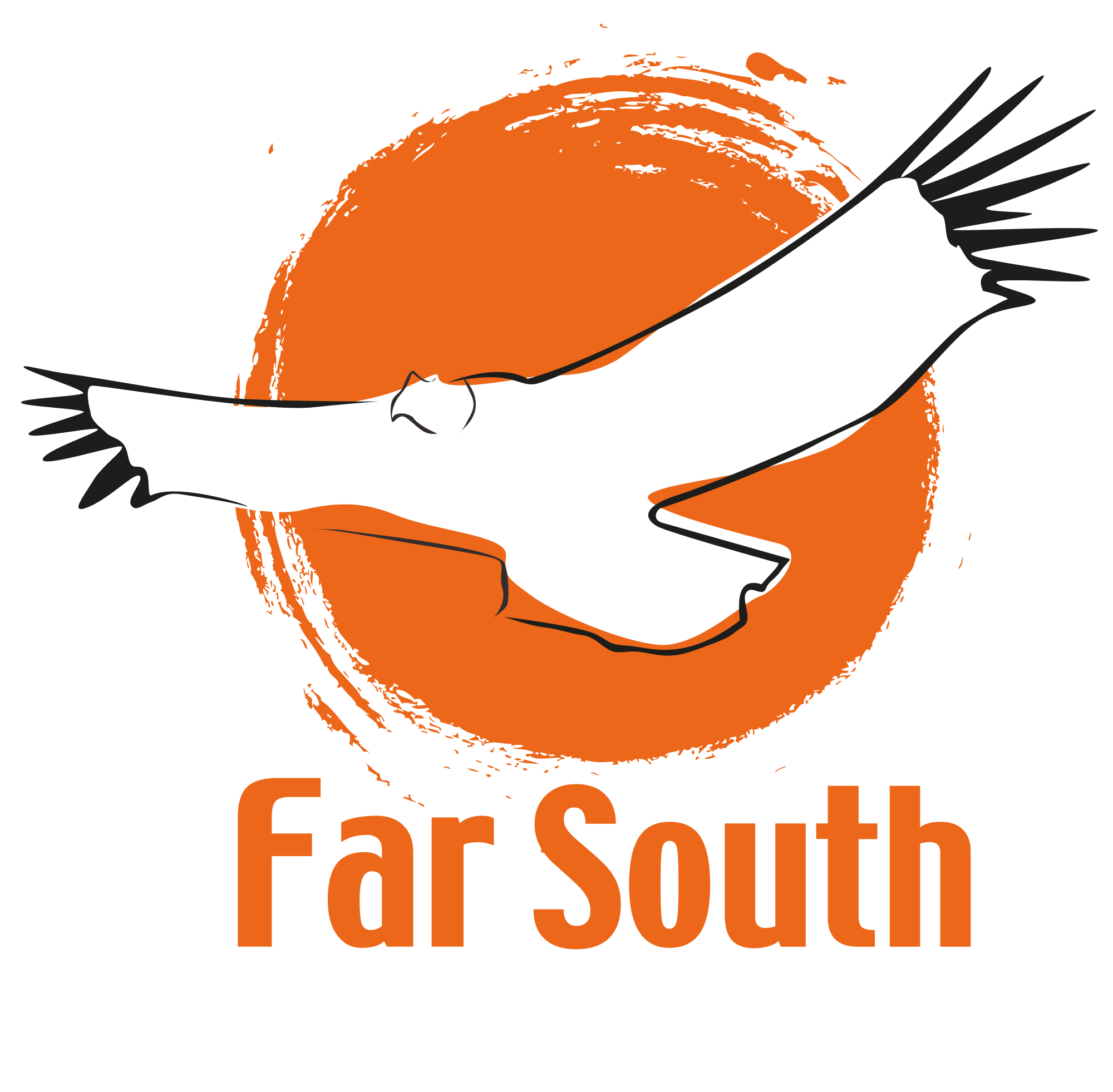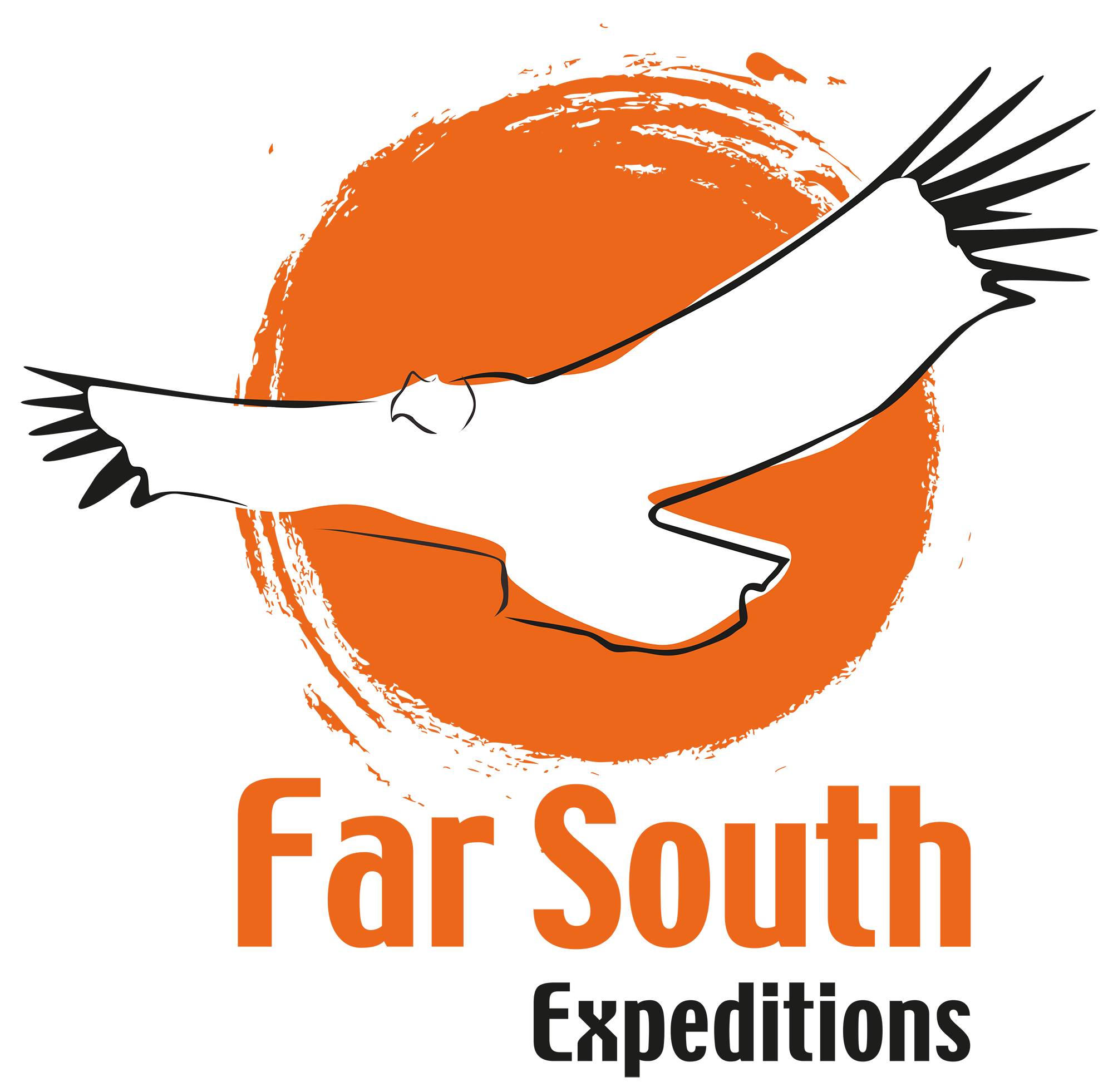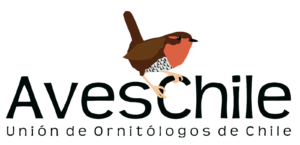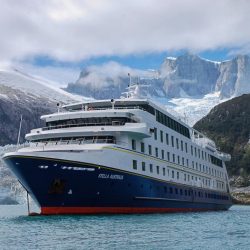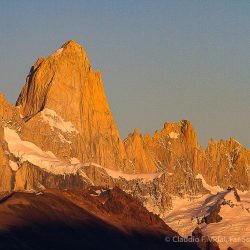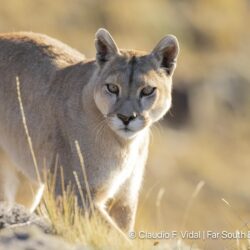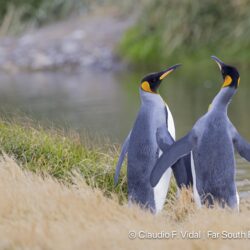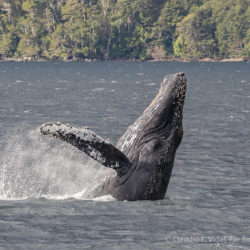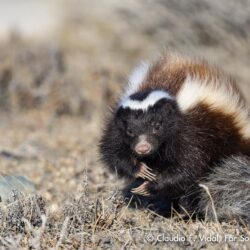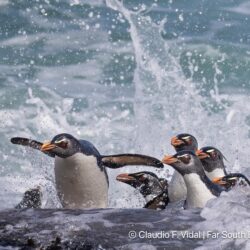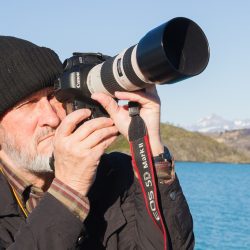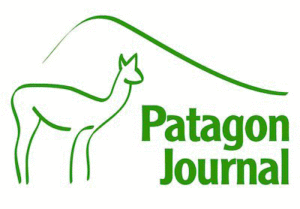We have added two exciting and very special expeditions to our 2019-2020 trip portfolio, exploring the sub-Antarctic islands along the Scotia Arc and the always awe-inspiring Antarctic Peninsula. The Falkland Islands (Islas Malvinas) are always a great introduction to the Southern Ocean marine wildlife and we will have the opportunity to explore Carcass and Saunders with its Rockhopper and Gentoo penguins and its Black-browed Albatross rookeries. Right after that, a couple of days sailing over the Scotia Sea will offer encounters with outstanding seabirds and cetaceans before reaching everybody’s favourite, the South Georgia Islands! This is truly one of the world’s greatest nature spectacles as every corner of their coasts is literally teeming with wildlife. Vast penguin colonies, albatrosses, petrels and elephant seals will be a true delight as we explore Prion Island, Salisbury Plain, St. Andrews and Fortuna Bays and the historic whaling station of Grytviken. The last portion of these expeditions will be devoted to explore the western side of the Antarctic Peninsula and its mind-blowing pristine landscapes. We will have several days to sail from the South Shetland Islands all the way south to the scenic Lemaire Channel, in the company of penguins and other seabirds, whales and hopefully Orcas.
Nov 03-23, 2019 aboard M/V Hondius with Rodrigo Tapia
The Falkland Islands, South Georgia & Antarctica
South Georgia Antarctica Wildlife Cruises | Meet at least six penguin species
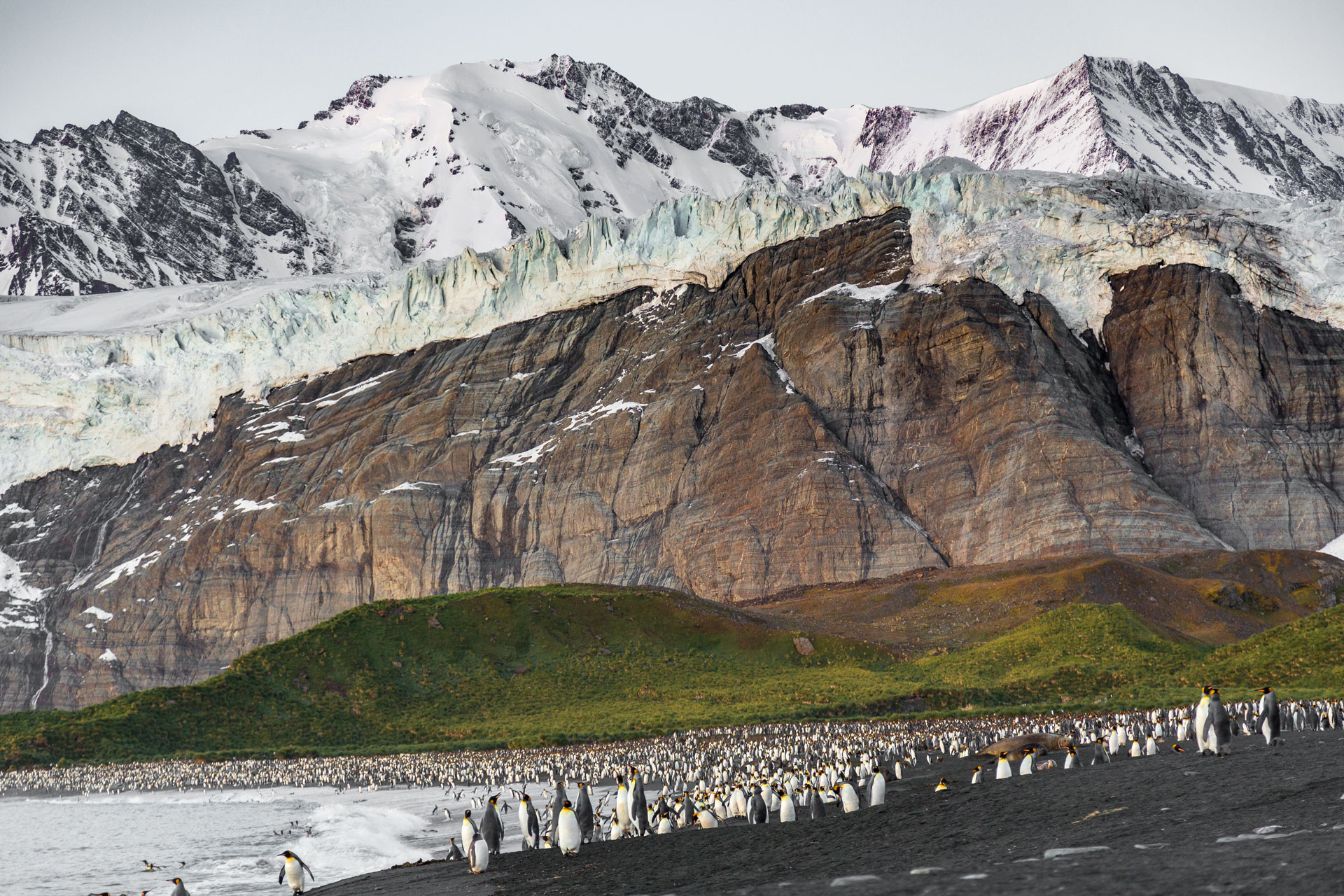
21-day cruise aboard M/V Hondius | Starts: Puerto Madryn – Ends: Ushuaia, Argentina | From $9,950 p.p.
Detailed Itinerary and Activities
| Title: | Falkland Islands - South Georgia - Antarctica |
| Dates: | 3 Nov - 23 Nov, 2019 |
| Trip Code: | ANT03 | HDS21-19 |
| Duration: | 20 nights |
| Ship: | m/v Hondius |
| Embarkation: | Puerto Madryn, Argentina |
| Disembarkation: | Ushuaia, Argentina |
| Language: | English-speaking voyage |
PLEASE NOTE: All itineraries are for guidance only. Programs may vary depending on local ice, weather, and wildlife conditions. The on-board expedition leader will determine the final itinerary. Flexibility is paramount for expedition cruises. The average cruising speed of m/v Hondius is 10.5 knots.
Day 1: Sandy Argentine beaches
South Georgia Antarctica Wildlife Cruises. You embark from Puerto Madryn in the afternoon, your prow aimed for the Falkland Islands. Golfo Nuevo is renowned for its visiting southern right whales, so you have a good chance of spotting one as you sail toward the open ocean.
Day 2 – 3: Sea life, sea birds
Though you’re now at sea, there’s rarely a lonesome moment here. Several species of bird follow the vessel southeast, such as albatrosses, storm petrels, shearwaters, and diving petrels.
Day 4: Finding the Falklands
The Falkland (Malvinas) Islands offer an abundance of wildlife that is easily approachable, though caution is always advised. These islands are largely unknown gems, the site of a 1982 war between the UK and Argentina. Not only do various species of bird live here, but chances are great you’ll see both Peale’s dolphins and Commerson’s dolphins in the surrounding waters.
During this segment of the voyage, you may visit the following sites:
Steeple Jason – Home to the world’s largest black-browed albatross colony (roughly 113,000), Steeple Jason is a wild and rarely visited island buffeted by wind and waves. Weather and swell conditions dictate the journey here.
Carcass Island – Despite its name, this island is pleasantly rodent-free and hence bounteous with birdlife. Anything from breeding Magellanic penguins and gentoos to numerous waders and passerine birds (including Cobb’s wrens and tussock-birds) live here.
Saunders Island – On Saunders Island you can see the black-browed albatross and its sometimes-clumsy landings, along with breeding imperial shags and rockhopper penguins. King penguins, Magellanic penguins, and gentoos are also found here. South Georgia Antarctica Wildlife Cruises
Day 5: The seat of Falklands culture
The capital of the Falklands and center of its culture, Port Stanley has some Victorian-era charm: colorful houses, well-tended gardens, and English-style pubs are all to be found here. You can also see several century-old clipper ships nearby, silent witnesses to the hardships of 19th century sailors. The small but interesting museum is also worth a visit, covering the early days of settlement up to the Falklands War. Approximately 2,100 people live in Port Stanley. Feel free to wander at will, though be aware that admission fees to local attractions are not included in the voyage.
Day 6 – 7: Once more to the sea
En route to South Georgia, you now cross the Antarctic Convergence. The temperature cools considerably within the space of a few hours, and nutritious water rises to the surface of the sea due to colliding water columns. This phenomenon attracts a multitude of seabirds near the ship, including several species of albatross, shearwaters, petrels, prions, and skuas.
Day 8 – 11: South Georgia journey
Today you arrive at the first South Georgia activity site. Please keep in mind that weather conditions in this area can be challenging, largely dictating the program. South Georgia Antarctica Wildlife Cruises
Sites you might visit include:
Prion Island – This location is closed during the early part of the wandering albatross breeding season (November 20 – January 7). The previous summer’s wandering albatross chicks are almost ready to fledge, and adults are seeking out their old partners after a year and a half at sea.
Salisbury Plain, St. Andrews Bay, Gold Harbour – These sites not only house the three largest king penguin colonies in South Georgia, they’re also three of the world’s largest breeding beaches for southern elephant seals. Only during this time of year do they peak in their breeding cycle. Watch the four-ton bulls keep a constant vigil (and occasionally fight) over territories where dozens of females have just given birth or are about to deliver. You can also see a substantial number of Antarctic fur seals here during the breeding season (December – January). South Georgia Antarctica Wildlife Cruises
Fortuna Bay – Near beaches inhabited by various penguins and seals, you have the chance to follow the final leg of Shackleton’s route to the abandoned whaling village of Stromness. This path cuts across the mountain pass beyond Shackleton’s Waterfall, and as the terrain is partly swampy, be prepared to cross a few small streams.
Grytviken – In this abandoned whaling station, king penguins walk the streets and elephant seals lie around like they own the place – because they basically do. Here you might be able to see the South Georgia Museum as well as Shackleton’s grave. South Georgia Antarctica Wildlife Cruises
Day 12: Southward bound
There may be sea ice on this route, and at the edge of the ice some south polar skuas and snow petrels could join the other seabirds trailing the vessel south.
Day 13: The scenic vistas of South Orkney
Depending on the conditions, you might visit Orcadas Base, an Argentine scientific station on Laurie Island in the South Orkney archipelago. The personnel here will happily show you their facility, where you can enjoy expansive views of the surrounding glaciers. If a visit isn’t possible, you may instead land in Signy Island’s Shingle Cove.
Day 14: Last push to the Antarctic
Enormous icebergs and a fair chance of fin whale sightings ensure there’s never a dull moment on this last sea voyage south. Also, your best chance to spot Antarctic petrels is here.
Day 15 – 18: Awe-inspiring Antarctica
If the ice conditions permit, you now sail into the Weddell Sea. Here colossal tabular icebergs herald your arrival to the eastern side of the Antarctic Peninsula. Paulet Island, with its large population of Adélie penguins, is a possible stop. You might also visit Brown Bluff, located in the ice-clogged Antarctic Sound, where you could get the chance to set foot on the Antarctic Continent itself. South Georgia Antarctica Wildlife Cruises
If conditions aren’t favorable to enter the Weddell Sea from the east, the ship will set course for Elephant Island and head into the Bransfield Strait, between South Shetland Island and the Antarctic Peninsula. Here you can attempt to access the Antarctic Sound from the northwest.
The volcanic islands of the South Shetlands are windswept and often cloaked in mist, but they nonetheless offer many subtle pleasures. A wide variety of flora (mosses, lichens, flowering grasses) and fauna (gentoo penguins, chinstrap penguins, southern giant petrels) live here. Chinstrap penguins and Weddell seals often haul out onto the beach near Cámara Base, an Argentine scientific research station on Half Moon Island.
On Deception Island, the ship plunges through Neptune’s Bellows and into the flooded caldera. Here you can find hot springs, an abandoned whaling station, and thousands of cape petrels. A number of kelp gulls, brown skuas, south polar skuas, and Antarctic terns can be spotted too. Wilson’s storm petrels and black-bellied storm petrels also nest in the ruins of the whaling station in Whalers Bay. As an alternative, you can take part in activities near Telefon Bay, further inside the caldera.
This extended voyage gives you the chance to sail even farther down the icy coast of the western Antarctic Peninsula. In the Gerlache Strait are several opportunities for great landings where you might set foot on the Antarctic Continent, surrounded by an epic landscape of alpine peaks and mammoth glaciers calving at sea level. Gentoo penguins, leopard seals, Weddell seals, humpback whales, and minke whales are often seen here.
The breathtaking scenery continues in the southern Gerlache Strait, and if ice conditions allow, we may even reach Lemaire Channel. Conditions on the Drake Passage determine the exact time of departure.
Day 19 – 20: Familiar seas, familiar friends
Your return voyage is far from lonely. While crossing the Drake, you’re again greeted by the vast array of seabirds remembered from the passage south. But they seem a little more familiar to you now, and you to them.
Day 21: Earth’s southernmost city
You arrive and disembark in Ushuaia, commonly held to be the world’s most southern city. It is located on the Tierra del Fuego archipelago, nicknamed the “End of the World.” But despite this stopping point, the wealth of memories you’ve made on your Antarctic expedition will travel with you wherever your next adventure lies. South Georgia Antarctica Wildlife Cruises
Trip Map
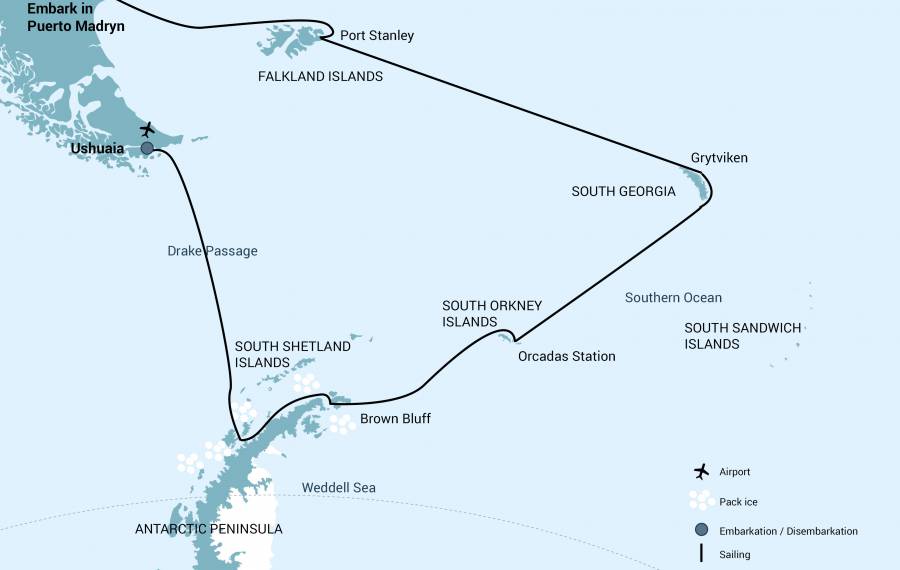
Cabins & Rates
| Quadruple Porthole | ||||||
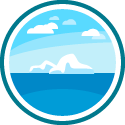 |  |  |  | 2 portholes 2 upper & lower berths Small sofa Private shower & toilet Flatscreen TV Desk & chair Telephone and WiFi (supplemented) Coffee & tea maker Hair dryer Cabinet Wardrobe Safe This cabin is suitable for families traveling with children, or passengers who do not require a twin or more luxurious cabin | Sharing berth Share your cabin with others for the best price | 9,950 USD |
| Complete cabin Price for the complete cabin, fully occupied. | 39,800 USD | |||||
| Triple Porthole | ||||||
 |  |  |  | 2 portholes 1 upper berth & 2 lower berths Small sofa Private shower & toilet Flatscreen TV Desk & chair Telephone and WiFi (supplemented) Coffee & tea maker Hair dryer Cabinet Wardrobe Safe This cabin is suitable for families traveling with children, or passengers who do not require a twin or more luxurious cabin | Sharing berth Share your cabin with others for the best price | 10,950 USD |
| Complete cabin Price for the complete cabin, fully occupied. | 32,850 USD | |||||
| Twin Porthole | ||||||
 |  |  |  | 2 portholes 2 single beds Small sofa Private shower & toilet Flatscreen TV Desk & chair Telephone and WiFi (supplemented) Coffee & tea maker Hair dryer Cabinet Wardrobe Safe | Sharing berth Share your cabin with others for the best price | 11,900 USD |
| Single cabin Price for the complete cabin occupied by 1 person (1.7x the shared rate). | 20,230 USD | |||||
| Complete cabin Price for the complete cabin, fully occupied. | 23,800 USD | |||||
| Twin Window | ||||||
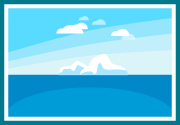 |  |  | 1 window 2 single beds Small sofa Private shower & toilet Flatscreen TV Desk & chair Telephone and WiFi (supplemented) Coffee & tea maker Hair dryer Cabinet Wardrobe Safe | Sharing berth. Share your cabin with others for the best price | 12,550 USD | |
| Single cabin. Price for the complete cabin occupied by 1 person (1.7x the shared rate). | 21,335 USD | |||||
| Complete cabin. Price for the complete cabin, fully occupied. | 25,100 USD |
|||||
| Twin Deluxe | ||||||
 |  |  |  | 2 windows 2 single beds Sofa Private shower & toilet Flatscreen TV Desk & chair Telephone and WiFi (supplemented) Refrigerator Coffee & tea maker Hair dryer Cabinet Wardrobe Safe | Sharing berth. Share your cabin with others for the best price. | 13,550 USD |
| Single cabin. Price for the complete cabin occupied by 1 person (1.7x the shared rate). | 22,695 USD | |||||
| Complete cabin. Price for the complete cabin, fully occupied. | 26,700 USD | |||||
| Superior | ||||||
 |  |  | 2 windows 1 double bed Sofa Private shower & toilet Flatscreen TV Desk & chair Telephone and WiFi (supplemented) Refrigerator Coffee & tea maker Hair dryer Cabinet Wardrobe Safe | Single cabin. Price for the complete cabin occupied by 1 person (1.7x the shared rate). | 24,395 USD | |
| Complete cabin. Price for the complete cabin, fully occupied. | 28,700 USD | |||||
| Junior Suite | ||||||
 |  |  | 1 double window 1 double bed Private shower & toilet Flatscreen TV Desk & chair Telephone and WiFi (supplemented) Refrigerator Coffee & tea maker Hair dryer Cabinet Wardrobe Safe | Single cabin. Price for the complete cabin occupied by 1 person (1.7x the shared rate). | 26,095 USD | |
| Complete cabin. Price for the complete cabin, fully occupied. | 30,700 USD | |||||
| Grand Suite with private balcony | ||||||
 |  |  | 1 double window 1 double bed Sofa Private balcony Private shower & toilet Flatscreen TV Desk & chair Telephone and WiFi (supplemented) Refrigerator Coffee & tea maker Hair dryer Cabinet Wardrobe Safe | Single cabin. Price for the complete cabin occupied by 1 person (1.7x the shared rate). | 29,580 USD | |
| Complete cabin. Price for the complete cabin, fully occupied. | 34,800 USD | |||||
| Hondius Suite | ||||||
 |  |  |  | 4 windows 1 double bed Sofa Private shower & toilet Desk & chair Flatscreen TV Telephone and WiFi (supplemented) Refrigerator Coffee & tea maker Hair dryer Cabinet Walk-in closet Safe | Single cabin. Price for the complete cabin occupied by 1 person (1.7x the shared rate). | 33,830 USD |
| Complete cabin. Price for the complete cabin, fully occupied. | 39,800 USD | |||||
Included in this voyage
• Voyage aboard the indicated vessel as indicated in the itinerary
• All meals throughout the voyage aboard the ship including snacks, coffee and tea.
• All shore excursions and activities throughout the voyage by Zodiac.
• Program of lectures by noted naturalists and leadership by experienced expedition staff.
• Free use of rubber boots and snowshoes.
• Pre-scheduled group transfer from the vessel to the airport in Ushuaia (directly after disembarkation).
• All miscellaneous service taxes and port charges throughout the programme.
• Comprehensive pre-departure material.
Excluded from this voyage
• Any airfare, whether on scheduled or charter flights
• Pre- and post- land arrangements.
• Passport and visa expenses.
• Government arrival and departure taxes.
• Meals ashore.
• Baggage, cancellation and personal insurance (which is mandatory).
• Excess baggage charges and all items of a personal nature such as laundry, bar, beverage charges and telecommunication charges.
• The customary gratuity at the end of the voyages for stewards and other service personnel aboard (guidelines will be provided).
M/V Hondius
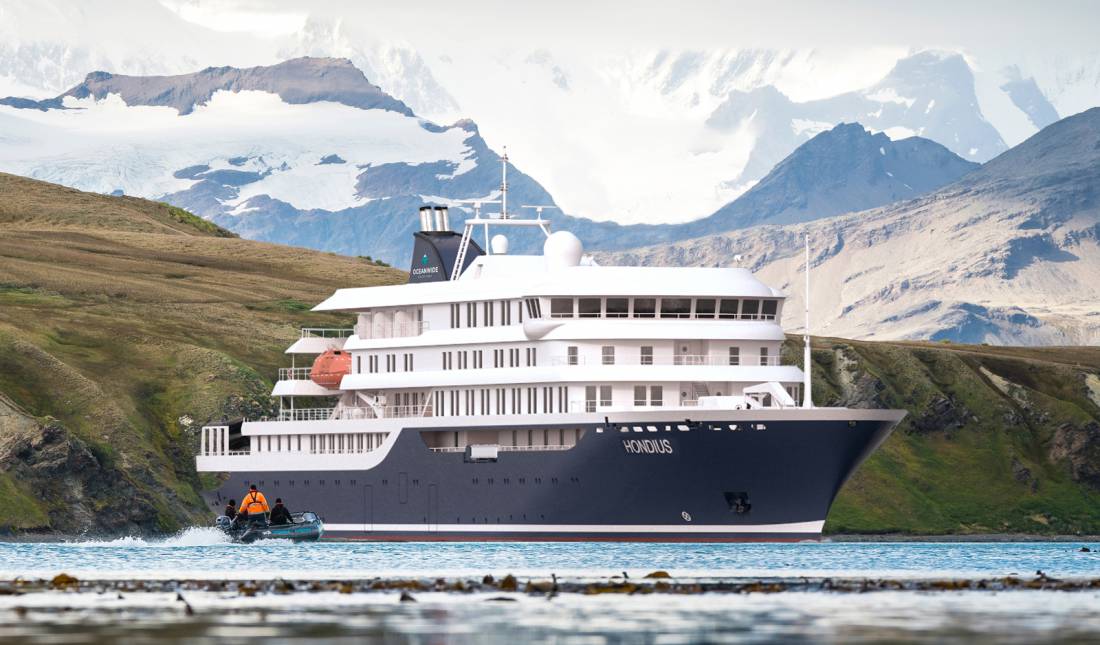
Hondius is the first-registered Polar Class 6 vessel in the world, optimized for the most innovative exploratory voyages throughout the Arctic and Antarctica.
Hondius is the first-registered Polar Class 6 vessel in the world, meeting the latest and highest Lloyd’s Register demands for ice-strengthened cruise vessels. Hondius also exceeds the requirements of the Polar Code as adopted by the International Maritime Organization (IMO), allowing you to enjoy the polar regions as much as possible while impacting them as little as possible. Upon completion, Hondius will be the most flexible, advanced, innovative ice-strengthened vessel in the polar regions. It is optimized for exploratory voyages that provide you the utmost first-hand contact with the Arctic and Antarctica.
| Passengers: | 170 in 80 cabins |
| Year of construction: | 2019 |
| Staff & crew: | 72 |
| Length: | 107.6 meters |
| Breadth: | 17.6 meters |
| Draft: | 5.30 meters |
| Ice class: | Polar Class 6 (equivalent 1A-Super) |
| Displacement: | 5,590 tonnes |
| Propulsion: | 2 x ABC main engines; total 4,200 kW |
| Speed max.: | 15 knots |
Hondius, ship details (.pdf)
Hondius, deck plan (.pdf)
Hondius brochure (.pdf)
Hotel comfort, expedition class
Hondius offers high-quality accommodation for 176 passengers in one spacious suite (35 square meters, 377 square feet), six grand suites with balconies (27 square meters, 291 square feet), eight junior suites (19 to 20 square meters, 205 to 215 square feet), eight superior cabins (20 to 21 square meters, 215 to 226 square feet), 11 twin deluxe cabins, (19 to 21 square meters, 205 to 226 square feet), 14 twin window cabins (12 to 14 square meters, 129 to 151 square feet) as well as 28 twin porthole cabins, two triple porthole cabins, and four quadruple porthole cabins that vary in size from 12 to 18 square meters, or 129 to 194 square feet. The passenger capacity certificate for Hondius is 196 persons. One deck consists of a large observation lounge and separate lecture room, which are reserved for a wide variety of interactive workshops, exhibitions, and performances particular to Hondius. Though elegantly designed in stylish mid-century modern décor, this vessel holds true to Oceanwide’s distinctive cozy and informal atmosphere.
Swift & safe ship-to-shore operations
It is our philosophy to keep sea time short so that we can focus instead on fast, effective access to shore and near-shore activities. To give you the maximum contact with the nature and wildlife you traveled so far to see, we employ a tough fleet of rigid-hull inflatable Zodiac boats that guarantee swift and safe landing operations for all passengers at the same time. Hondius has two separate gangways and a sheltered indoor Zodiac embarkation platform that can also be used for special outdoor activities, such as kayaking.
The fast, flexible, friendly heart of the polar regions
Our top priority is taking advantage of every wildlife and terrain opportunity as it occurs. To keep our itineraries flexible itineraries and our response time rapid, Hondius is equipped with advanced stabilizers and two main engines capable of powering the vessel up to 15 knots. But Hondius sacrifices no warmth to achieve its keen polar edge: You will have 72 crew and staff members (including expedition and hotel staff) at your service while on board, ensuring that what little time you do spend on the ship you will spend comfortably entertained.
Launching summer 2019
Hondius is currently under construction by Brodosplit in Croatia and is set to launch summer 2019. We will soon announce planned sailing programs.
Age and nationality
Passengers on a typical voyage range from in their 30s to their 80s, with the majority usually between 45 ― 65. Our expeditions attract independent travelers from around the globe who are characterized by a strong interest in exploring remote regions. The camaraderie that develops on board is an important part of the Oceanwide experience, and many passenger groups include several nationalities.
What to wear
In keeping with the spirit of expedition, dress on board is informal. Bring casual and comfortable clothing for all activities, and keep in mind that much of the scenery can be appreciated from deck ― which can be slippery. Bring sturdy shoes with no-slip soles, and make sure your parka is never far away in case one of our crew shouts “Whales!” over the loudspeaker and you have to dash outside in a moment’s notice. Opt for layers, as it is comfortably warm aboard the ship though often cold on deck.
How to pay
Refreshments and souvenirs will be charged to your cabin. The day before departure you can settle your bill with the hotel manager, paying by credit card (Visa or MasterCard) or cash (euro, or in some cases dollar). We cannot, however, accept checks. Though the prices and standard currency on board is in the euro, other currencies may be accepted at the discretion of the hotel manager, at prevailing rates.
Electric current
The electrical supply aboard ship is 220v, 60Hz. Electrical outlets are standard European with two thick round pins, so some passengers may need a 220v/110v converter.
Gratuities
The customary gratuity to the ship’s service personnel is made as a blanket contribution at the end of the voyage and is divided among the crew. Tipping is a personal matter, and the amount you wish to give is at your sole discretion. As a generally accepted guideline, we suggest 8 ― 10 euros per passenger per day. It is better for the crew if you give cash.
Non-smoking policy
We have a non-smoking policy inside all our vessels, though you can smoke in certain designated areas. We ask that you please respect the wishes of non-smokers.
Your physical condition
You must be in good overall health and be able to walk several hours per day. The expedition is ship-based and physically not very demanding, but we spend as much time as possible on shore. You are, however, welcome to remain aboard the ship if you prefer. To join most excursions you must be able to get up and down the steep gangway ― from the ship to the water level ― to board the Zodiacs. Staff will assist you in and out of the boats, and boarding will become progressively easier with practice, but conditions on shore can be slippery and rocky. Remember, you will be traveling in remote areas without access to sophisticated medical facilities, so you must not join this expedition if you have a life-threatening condition or need daily medical treatment.
Rodrigo Tapia & Staff of M/V Hondius
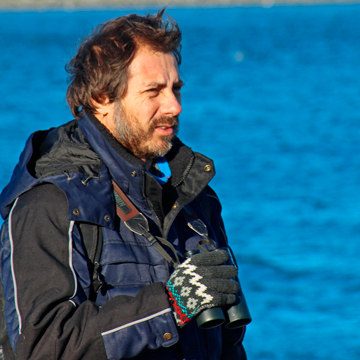
Rodrigo Tapia
Rodrigo started his long-time love relationship with birds when he became an avid birder by the age of 10, and has been observing, studying and learning about them for more than 30 years now, first by birding in many different environments from the seaside to the Andes mountains around his home patch, acquiring in the process a good deal of field experience with virtually all the birds of central Chile including most chilean endemics, and later expanding his voyages to the rest of the country. This early passion naturally evolved into his career and led him into studying Biology at Universidad Católica de Valparaíso and further studying with Cornell Lab of Ornithology.
He has explored Chile’s whole length from the northern Altiplano to Cape Horn while conducting ornithological research and guiding groups of birders since 1989. He studied the birds in the wetlands of the Aconcagua river and Mantagua for three years, gathering experience with shorebirds, plovers, waders and coastal seabirds. Rodrigo travelled to Antarctica for the first time in 1991 as part of a research team conducting studies on antarctic penguins, and later worked for eight seasons in the White Continent as an expedition leader, lecturer and zodiac driver on board a couple of vessels. These years of sailing across the Drake Passage, together with the experience gathered in pelagic birding off his hometown of Valparaíso in the Pacific coast of central Chile gave him hundreds of hours with albatrosses, petrels and other seabirds, a group of birds which has always captivated him.
Member of the Chilean Ornithologists Union, he has worked as a birding guide, as an independent researcher, and as a birding consultant and guide instructor for several nature-oriented hotels and lodges. He´s also interested in bird photography. Rodrigo has been involved in several environmental education projects with children, imparted workshops and lectured about birds and birding, and has worked to try and get the public attention on birds, their knowledge and conservation, and birdwatching as a sustainable economic activity. In this context he was the mind behind Festival de Aves de Chile, in 2008, the first ever bird festival in Chile, an event that is still celebrated every year in the city of Viña del Mar and has spurred the apparition of similar bird-centered community events throughout the country. He started guiding birding tours and pelagics in central Chile for Far South Expeditions in 2006 and currently works for us as a full-time birding, wildlife and wildlife photo trip leader and writer since 2012 when he moved to Punta Arenas.
Tour Registration
To book this tour, please fill in our online registration form. We will process your booking and will send you a note with space confirmation and a transfer invoice with payment instructions within 24 hours. The transfer amount is 500 USD per person. Full payment of the tour fee is due 90 days prior to tour departure.
NOTE: Inquiries received on Saturdays, Sundays and Holidays will be replied to during the following working day.
Cancellation Policy
Notice of cancellation can only be accepted IN WRITING from the person who signed the booking form and takes effect on the day such noticed is received by us.
Refunds are made according to the following schedule:
• If cancellation is made 120 days or more before departure date, the transfer amount minus 200 USD is refundable.
• If cancellation is made between 120 and 60 days before departure, the transfer is not refundable, but any payments covering the balance of the fee will be refunded.
• If cancellation is made less than 60 days before departure date, no refund is available.
This policy and fee schedule also applies to pre-trip and post trip extensions, as well as any transfers from one tour to another. We strongly recommend the purchase of trip cancellation insurance to protect yourself.
south georgia antarctica wildlife cruises | south georgia antarctica wildlife cruises | south georgia antarctica wildlife cruises | south georgia antarctica wildlife cruises | south georgia antarctica wildlife cruises | south georgia antarctica wildlife cruises | south georgia antarctica wildlife cruises | south georgia antarctica wildlife cruises | south georgia antarctica wildlife cruises | south georgia antarctica wildlife cruises | south georgia antarctica wildlife cruises | south georgia antarctica wildlife cruises | south georgia antarctica wildlife cruises | south georgia antarctica wildlife cruises | south georgia antarctica wildlife cruises |
Write or call for availability:
tours@farsouthexpeditions.com
+56 61 261-5793

